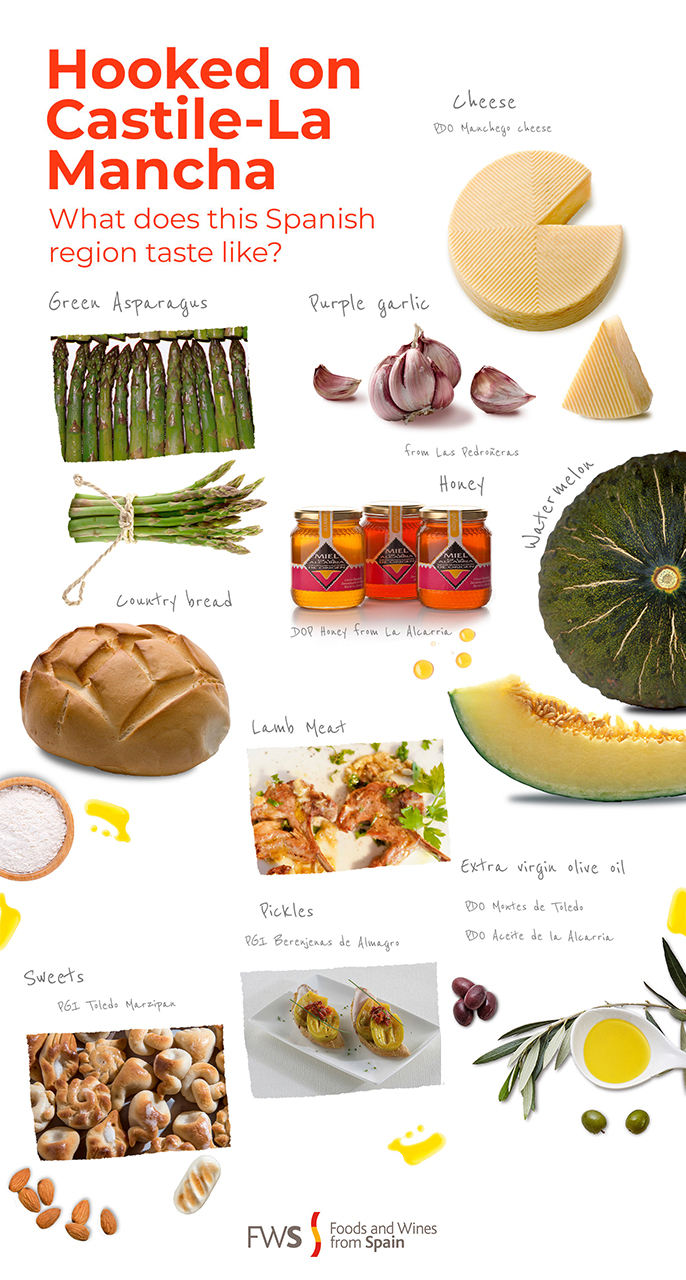.png.transform/rendition-xs/image_image%20(1).png)
Infographics: What Do Castile-La Mancha Taste Like?
Castile-La Mancha is one of Spain's largest regions and is home to a selection of emblematic products such as Manchego cheese, saffron and purple garlic. But there's so much more...

We're all familiar with its landscape: vast plains, whitewashed villages and towering windmills that provided inspiration to famed author Miguel de Cervantes (1527-1616) for one of the storylines in his novel Don Quijote de La Mancha.
At present, this region, which is located on Spain's meseta central, is home to many wonderful tourist attractions such as UNESCO World Heritage cities (Toledo, Cuenca), environmentally-important nature reserves (Lagunas de Ruidera, Tablas de Daimiel, Alto Tajo, Sierra de Alcaraz, Cabañeros National Park, etc.), a tourism and cultural route revolving around Don Quijote de la Mancha... and, unsurprisingly, a varied selection of foods full of local flavors with a lot of personality. Would you like to try them with us?
The regional product that has acquired the most international fame is Manchego cheese, produced in the Protected Designation of Origin (PDO) of the same name. It's a benchmark for cured cheeses made with pasteurized or raw sheep's milk (in the case of Artisanal Manchego Cheese), which comes only from the Manchega breed of sheep, which are native to the region. It's a firm, compact cheese with a truly distinct aroma and flavor.
The same sheep are also the source of incredibly tender meat used as the primary ingredient in some of the region’s most popular dishes, and Castile-La Mancha is also extremely well known for the excellent quality of its small and large game. It's worth mentioning the red-legged partridge as well, masterfully prepared in many restaurants in the region, and the fantastic tinned game (quail, partridge, pâtés, etc.).
If we're talking about international prestige, saffron from La Mancha is a premium product that is fantastically exclusive: it's produced in very limited quantities in line with extremely rigorous guidelines.
The region's orchards and farmland are also the source of wonderful products like wild asparagus, honeydew, different types of fruit trees... and one product in particular that has become famous around the world: purple garlic from Las Pedroñeras, with its own Protected Geographical Indication and unique nutritional and organoleptic qualities.
Another singular product from this large Spanish region is a small local variety of eggplant grown exclusively in the town of Campo de Criptana and sold in cans with a dressing made with vinegar, salt, cumin, garlic, paprika and olive oil—a first-rate appetizer.
For people with a sweet tooth, there are many irresistible products in Castile-La Mancha. One is artisanal honey, made in the town of La Alcarria, with its own Protected Designation of Origin and available in three varieties: lavender, rosemary and polyfloral. And then there's marzipan from Toledo, a delicious Spanish dessert of Arabic origin made from almonds and sugar.
Many consumers don't know this, but Castile-La Mancha is one of the main producers of extra virgin olive oil and it's home to a leading variety: Cornicabra. Olive oils produced under the following Protected Designations of Origin also deserve to be mentioned: Aceite de La Alcarria, Montes de Toledo, Campo de Calatrava and Campo de Montiel. And nothing makes a better appetizer than drizzling extra virgin olive oil over a slice of one of the most delicious artisan breads, Pan de Cruz, made with candeal flour in the province of Ciudad Real. It's a round loaf of bread with two perpendicular cuts in the crust, made with a knife, in the shape of a cross.
And now this article has come full circle: in the 17th century, Miguel de Cervantes wrote about Pan de Cruz in one of the passages in his novel Don Quijote de la Mancha... Do you think you can find it?
Text: Rodrigo García Fernández /@ICEX.
Translation: Samara Kamenecka /@ICEX.

